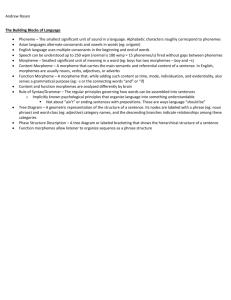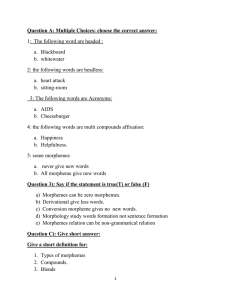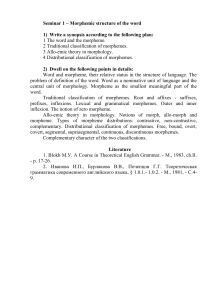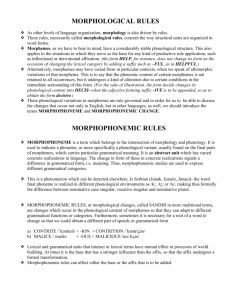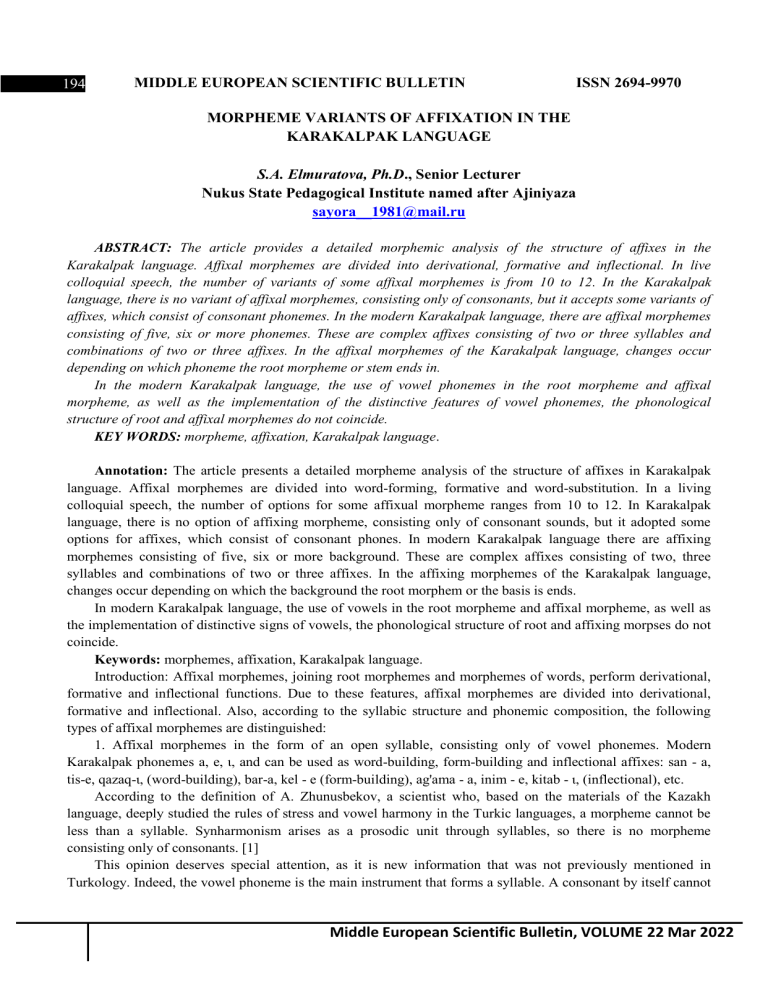
194 MIDDLE EUROPEAN SCIENTIFIC BULLETIN ISSN 2694-9970 MORPHEME VARIANTS OF AFFIXATION IN THE KARAKALPAK LANGUAGE S.A. Elmuratova, Ph.D., Senior Lecturer Nukus State Pedagogical Institute named after Ajiniyaza sayora__1981@mail.ru ABSTRACT: The article provides a detailed morphemic analysis of the structure of affixes in the Karakalpak language. Affixal morphemes are divided into derivational, formative and inflectional. In live colloquial speech, the number of variants of some affixal morphemes is from 10 to 12. In the Karakalpak language, there is no variant of affixal morphemes, consisting only of consonants, but it accepts some variants of affixes, which consist of consonant phonemes. In the modern Karakalpak language, there are affixal morphemes consisting of five, six or more phonemes. These are complex affixes consisting of two or three syllables and combinations of two or three affixes. In the affixal morphemes of the Karakalpak language, changes occur depending on which phoneme the root morpheme or stem ends in. In the modern Karakalpak language, the use of vowel phonemes in the root morpheme and affixal morpheme, as well as the implementation of the distinctive features of vowel phonemes, the phonological structure of root and affixal morphemes do not coincide. KEY WORDS: morpheme, affixation, Karakalpak language. Annotation: The article presents a detailed morpheme analysis of the structure of affixes in Karakalpak language. Affixal morphemes are divided into word-forming, formative and word-substitution. In a living colloquial speech, the number of options for some affixual morpheme ranges from 10 to 12. In Karakalpak language, there is no option of affixing morpheme, consisting only of consonant sounds, but it adopted some options for affixes, which consist of consonant phones. In modern Karakalpak language there are affixing morphemes consisting of five, six or more background. These are complex affixes consisting of two, three syllables and combinations of two or three affixes. In the affixing morphemes of the Karakalpak language, changes occur depending on which the background the root morphem or the basis is ends. In modern Karakalpak language, the use of vowels in the root morpheme and affixal morpheme, as well as the implementation of distinctive signs of vowels, the phonological structure of root and affixing morpses do not coincide. Keywords: morphemes, affixation, Karakalpak language. Introduction: Affixal morphemes, joining root morphemes and morphemes of words, perform derivational, formative and inflectional functions. Due to these features, affixal morphemes are divided into derivational, formative and inflectional. Also, according to the syllabic structure and phonemic composition, the following types of affixal morphemes are distinguished: 1. Affixal morphemes in the form of an open syllable, consisting only of vowel phonemes. Modern Karakalpak phonemes a, e, ɩ, and can be used as word-building, form-building and inflectional affixes: san - a, tis-e, qazaq-ɩ, (word-building), bar-a, kel - e (form-building), ag'ama - a, inim - e, kitab - ɩ, (inflectional), etc. According to the definition of A. Zhunusbekov, a scientist who, based on the materials of the Kazakh language, deeply studied the rules of stress and vowel harmony in the Turkic languages, a morpheme cannot be less than a syllable. Synharmonism arises as a prosodic unit through syllables, so there is no morpheme consisting only of consonants. [1] This opinion deserves special attention, as it is new information that was not previously mentioned in Turkology. Indeed, the vowel phoneme is the main instrument that forms a syllable. A consonant by itself cannot Middle European Scientific Bulletin, VOLUME 22 Mar 2022 195 MIDDLE EUROPEAN SCIENTIFIC BULLETIN ISSN 2694-9970 form a syllable. Secondly, in the Turkic languages, including Karakalpak, in cases where two vowels go in a row, a consonant phoneme is placed between them or one of the two vowel phonemes is dropped. In all modern Turkic languages, a variant of the morpheme is now indicated, consisting only of consonants. However, if we adhere to the opinion of A. Zhunisbekov, then it must be recognized that there is no variant of the morpheme, consisting only of consonants. Because if the root morpheme or the stem of a word ends in a consonant phoneme and an affixal morpheme starting with a vowel phoneme or a second root morpheme joins it, then the first of two consecutive phonemes drops out. Our idea that in modern Turkic languages there may be variants of a morpheme consisting only of consonants, arose on the basis of the above opinion, which says that the first of two consecutive phonemes is dropped. Indeed, when vowel phonemes are in a row, the first vowel sound is skipped, i.e. not pronounced. The following examples clearly confirm this: jeti+eў, sari- ala=sarala, taraaq=taraq, etc. In his work, A. Davletov supports the opinion of A. Zhunisbekov and states [2] that in the Karakalpak language there is no variant of affixal morphemes consisting only of consonants, but some variants of affixes are accepted in it, which consist of consonant phonemes. We fully agree with the opinion of A. Zhunisbekov. Affixal morphemes in the form of open and closed syllables, consist of two phonemes. There are a lot of them in the modern Karakalpak language: ik//=ɩk, =аq//еq, =ma//=me, etc. They perform three functions: derivational, formative and inflectional. In the modern Karakalpak literary language, two-phonemic morphemes have from two to six variants. And in live colloquial speech, the number of variants of some affixal morphemes is from 10 to 12. In the modern Karakalpak language, three-phonemic affixal morphemes are also common. They are used in the form consonant + vowel + consonant, vowel + consonant + vowel. Among the three-phonemic affixal morphemes, morphemes in the form of a covered syllable with the structure: consonant + vowel + consonant occupy a special place, both in terms of quantity and use, and in terms of the variety of functions and variants. A variant of the three-phonemic morpheme - vowel + consonant-vowel consists of one syllable, and there are not so many of them: =asɩ//=esi, =ira//=ire, etc. Four-phonemic affixal morphemes are monosyllabic and two-syllable. Monosyllabic four-phoneme affixal morphemes have the following phonemic structure: +consonant + vowel + consonant + consonant or consonant + consonant + vowel + consonant (eg -stan). However, there are few of them, and they exist only in a single version. Two-syllable four-phoneme affixal morphemes have the following structure: + consonant + vowel + consonant + vowel (e.g. -nama, zada, -khana, etc.) or + vowel + consonant + vowel + consonant (e.g. =alaq, ayiq/ /=eyik etc.). In the modern Karakalpak language, there are affixal morphemes consisting of five, six or more phonemes. These are complex affixes consisting of two and three syllables and a combination of two or three affixes. These include affixes of the adverbial form of the verb, the state verb, the nominal form of the verb, as well as some derivational affixes: -tug'in, =g’anliq//=genlik, etc. In the modern Karakalpak literary language, the phonemes a’ and o’ are not used in affixal morphemes, but they can be used in live colloquial speech and in dialects of the language. In the work of D.S. Nasyrov and O. Dospanov noted [3] that in the southwestern dialect of the Karakalpak language, the phoneme a' is used in affixal morphemes in those places where the phoneme e is used in the literary language. In the Karakalpak language, the plural affixes = lar // = ler are mentioned in the work of A. Dauletov [4]. So, in the words ko’ller, guler, in connection with the lip harmony of vowels, the phoneme e in affixal morphemes is replaced by the phoneme o’, but not in writing, but only in live colloquial speech. In the affixal morphemes of the Karakalpak language, changes occur depending on which phoneme the root morpheme or stem ends in. This also leads to many variants of affixal morphemes. Multivariant affixal morphemes are attached to the root and stem according to the law of vowel harmony: if the root or stem ends in a vowel or a voiced consonant phoneme, a variant of the affixal morpheme is added to it, which begins with a vowel or voiceless consonant phoneme. In this case, the phenomena of assimilation, replacement or loss of sounds are often encountered. If the root or stem of a word ends in a voiceless consonant phoneme, a variant of Middle European Scientific Bulletin, VOLUME 22 Mar 2022 196 MIDDLE EUROPEAN SCIENTIFIC BULLETIN ISSN 2694-9970 the affixal morpheme, beginning with a voiceless consonant, is added to it. Sound changes are rare here. Undoubtedly, not all affixal morphemes in the Karakalpak language have many variants. There are also affixal morphemes borrowed from Arabic and Persian: kesh, -xana, -stan-ker, etc. They are attached to a root or stem, no matter what phoneme they end in. This is due to the lack of synharmonism in the Arabic and Persian languages. In general, root and affix morphemes, along with a general similarity in phonological structure, also have differences in the use of vowel and consonant phonemes, as well as in syllable structure. Both in root morphemes and in affixal morphemes there are closed syllables in the form consonant + vowel + consonant. This confirms the opinion that in the Turkic languages the original root morphemes consisted of three phonemes. The fact that root morphemes cannot consist of vowels alone, and also of consonants alone, with the exception of some particles and interjections, indicates a general connection with the rule that the use of some vowel phonemes is limited and the formation of words from consonants alone is impossible. Based on the foregoing, we agree that the assumptions that auxiliary words and affixes are derived from meaningful words are close to objective reality. The Karakalpak language does not have a root morpheme consisting of only consonants. This situation does not occur even in interjections and particles. This once again confirms the opinion that there is no such affixal morpheme, which consists of only consonants. In the modern Karakalpak language, the use of vowel phonemes in the root morpheme and affixal morpheme, as well as the realization of the distinctive features of vowel phonemes, as well as the phonological structure of root and affixal morphemes do not coincide. In root morphemes, all phonemes are used, but in affixal morphemes, the use of phonemes a' and o' is limited. The phonemes o', ү, u are used only in live colloquial speech, they are not present in the written form of the literary language. Due to the absence of some vowel phonemes in affixal morphemes, the realization of their distinctive features is impossible. Distinctive features of vowels, such as: depth of articulation (high-low), degree of mouth opening (degree of open/closed vowels), labialization cannot be realized in all linguistic units (words, morphemes, phonemes, etc.) and not always participate in opposition. “For each of them there is a fixed sign for opposition: words are contrasted by the depth of articulation, words with high front vowels and low vowels of the middle and back rows, root morphemes are opposed by the participation of lips, and affixal morphemes by the degree of openness / closeness” [ 1]. In this regard, in the variants of affixal morphemes in the written literary language, only this feature of vowel phonemes is taken into account. This is correct in some way, but at the same time complicates the writing process. In the orthography of the Karakalpak language, labial vowels u, ү, e are not used in affixal morphemes, and synharmonic variants of affixal morphemes have not yet been specially studied. Currently, special attention is paid to the law of vowel harmony, and the need to take into account its manifestations in writing. Indeed, taking into account the manifestations of the law of vowel harmony, it is possible to preserve colloquial speech, convergence of two forms of the literary language - oral and written, convenience of writing and full implementation of the law of vowel harmony. In variants of affixal morphemes, the alternation of phonemes a-e-o is observed in the affixes lar - ler, which represent the plural. The reasons for their alternation are as follows. Previously, in root morphemes, the phoneme "a" and the phoneme "e" entered into opposition to each other. Later, with the introduction of the phoneme a’ into the Turkic languages, including Karakalpak, under the influence of Arabic, the phoneme a and the phoneme a’ formed an opposition in root morphemes as high and low vowels. In the modern Karakalpak literary language, the phoneme a' is not used in affixal morphemes. Therefore, the phoneme a and a' are opposed to each other. The alternation of the phoneme o' with the phonemes a and e is connected with the lip harmony of vowels. As a result of the influence of the labial vowel phoneme, a variant lo'r of the affix = lar - ler also appears in the root morpheme. Which of these variants will be used in the formation of a word depends on the vowel phoneme in the root morpheme. M.A.Cherkassky developed a model of the vowel harmony of the Turkic languages, taking into account the fact that the vowel in the root of the word determines the vowel harmony of the word, and the Middle European Scientific Bulletin, VOLUME 22 Mar 2022 197 MIDDLE EUROPEAN SCIENTIFIC BULLETIN ISSN 2694-9970 vowel in the affix will depend on the nature of the vowels of the previous syllable. [5] Conclusion: Thus, the main source in the alternation of vowel phonemes in variants of affixal morphemes is vowel harmony. Vowel phonemes in affixal morphemes alternate due to its function of organizing the phonetic structure of the word. LIST OF USED LITERATURE 1. Dzhunusbekov A. Problems of Turkic verbal prosody and synharmonism of the Kazakh language. Abstract of documentary diss. –Alma-ata 1988 p.2 2. Dauletov A. Azirgi Karakalpak Tili. Phonetics. Nukus 1999. S.260-265 3. Nasyrov.D., Dospanov O. Karakalpak dialectology. – Nukus. 1996 S.68-71 4. Dauletov A. Karakalpak tili singharmoniyasy.-Nukus. 1993 p.35 5. Cherkassky M.A. Turkic vocalism and synharmonism-M. 1965. p.10 6. Vinogradsky V.A. Interpretation of synharmonism as a morphological phenomenon - In the book problems of structural linguistics.-M; 1972.p.347 7. Khazirgi Karakalpak Adebiitilininggrammatikas. Sѳzhasalyў ӽǝm morphology. – Nukus. Bilim 1944. P.48 8. Shamshetova, Y. M., & Elmuratova, S. A. (2021). Phonological Structure of Borrowed Words in the Karakalpak. PSYCHOLOGY AND EDUCATION, 58(2), 1198-1204. 9. Shamshetova, Yu. M. (2018). Morphonological phenomena in the verb system of the Karakalpak language. Young Scientist, (42), 253-255. Middle European Scientific Bulletin, VOLUME 22 Mar 2022


